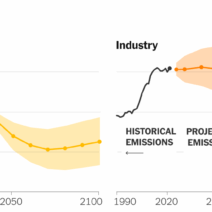Global warming has emerged as one of the most pressing challenges of our time, primarily driven by the activities of a handful of industrial giants. These corporations, through their operations and practices, contribute significantly to greenhouse gas emissions, exacerbating climate change. Understanding who these entities are and the mechanics behind their contributions is vital for fostering awareness and driving change. Here, we explore the top five industrial titans that have made indelible marks on our planet’s climate.
1. ExxonMobil: The Titan of Fossil Fuels
As one of the world’s largest publicly traded oil and gas companies, ExxonMobil has long been a focal point in discussions surrounding fossil fuel dependence. Despite the company’s participation in renewable energy research, its core operations are deeply entrenched in oil extraction and refining. As a significant extractor of crude oil, ExxonMobil is responsible for millions of tons of carbon dioxide emissions annually. Analysts argue that the extensive lobbying efforts employed by the corporation have stymied global climate policy reforms. ExxonMobil’s historical position of skepticism regarding the science of climate change has also fueled public discourse, revealing a broader challenge regarding corporate accountability and environmental stewardship.
2. Chevron: Controversial Practices and Impacts
Chemical engineering and energy production define Chevron’s identity in the industrial landscape. The company’s operations extend from oil and gas exploration to the significant loss of biodiversity and water resource depletion in areas they extract from. Chevron’s history is marred by environmental disasters, notably in Ecuador, where oil spills have wreaked havoc on the Amazon rainforest. This environmental degradation poses existential threats not only to local communities but also accelerates climate change through the release of greenhouse gases. Despite apparent advances in technology and renewable energy investments, the bulk of Chevron’s portfolio remains fossil fuel-centric, leading to persistent scrutiny and public outcry.
3. BP (British Petroleum): A Legacy of Environmental Catastrophes
Despite rebranding efforts to showcase a commitment to sustainable energy, BP still embodies the challenges tied to large fossil fuel enterprises. The infamous Deepwater Horizon oil spill remains one of the most catastrophic ecological disasters in history, underscoring the environmental risks entwined with oil extraction. BP’s operations have frequently resulted in oil spills and emissions that threaten marine and terrestrial ecosystems. Critically, the company’s strategic pivot towards renewable energy has often been seen as insufficient compared to its fossil fuel investments. Thus, BP symbolizes the dichotomy within corporations that endeavor to pursue a greener image while remaining largely beholden to outdated energy models.
4. Coal India Limited: The Coal Behemoth
In the context of global warming, the significance of coal cannot be overstated. As the largest coal producer in the world, Coal India Limited plays a considerable role in carbon emissions. The processes involved in coal mining, particularly open-pit mining, lead to extensive land degradation and soil erosion. The burning of coal generates substantial air pollutants, primarily carbon dioxide, which is a principal driver of global warming. Coal India’s operations epitomize the global dependency on coal for energy; however, this reliance raises critical questions concerning energy transition and sustainable practices that can mitigate climate impacts. The environmental ramifications of coal extraction are dire, warranting intensified scrutiny and advocacy for cleaner energy alternatives.
5. ArcelorMittal: Steel Production and Carbon Footprint
As the world’s leading steel and mining company, ArcelorMittal epitomizes heavy industry’s contribution to greenhouse gas emissions. The steel production process is notoriously carbon-intensive, releasing vast amounts of CO2 into the atmosphere. The company has acknowledged the need for more sustainable practices and has made investments in technologies to reduce emissions. Nevertheless, the sheer scale of its operations continues to pose a significant threat to climate stability. Furthermore, the lifecycle of steel—from extraction to production—has notable ecological and social ramifications that are often overlooked. The urgency for adopting circular economy principles and reducing reliance on fossil fuels remains paramount.
Conclusion: The Imperative for Change
The persistent dominance of these industrial giants in global markets highlights a broader systemic issue that intertwines economics with environmental sustainability. Each company embodies the conflicts inherent in transitioning toward a low-carbon economy, illuminating the intricate dance between corporate interests and climate health. The challenge is not merely to target these corporations but to reimagine the structures that enable destructive practices. It is imperative for consumers, lawmakers, and activists to demand transparency, accountability, and a significant pivot towards sustainable practices. The time for complacency has long since passed; we must advocate for policies that incentivize sustainable development, ultimately reducing our reliance on damaging industrial practices.
In summation, addressing climate change necessitates scrutinizing the actions of major industrial players. They are not merely contributors to global warming; they are a reflection of our collective economic choices and values. The path forward must prioritize sustainable practices, innovative technologies, and a paradigm shift away from fossil fuels, securing a healthier planet for future generations.







